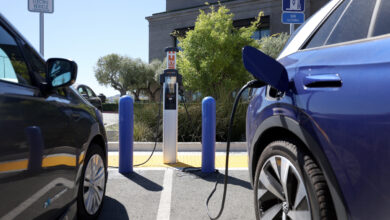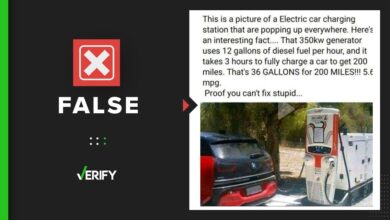Consumer interest in electric vehicles is falling, per AAA – Central New York Business Journal

Survey also finds respondents prefer hybrids as alternative A new survey from AAA finds consumers’ interest in buying a fully electric car is declining. Only about one in five adults surveyed (18 percent) say they’d be “very likely” or “likely” to buy a new or used electric vehicle (EV) (not a hybrid), down […]
Survey also finds respondents prefer hybrids as alternative
A new survey from AAA finds consumers’ interest in buying a fully electric car is declining.
Only about one in five adults surveyed (18 percent) say they’d be “very likely” or “likely” to buy a new or used electric vehicle (EV) (not a hybrid), down from 23 percent last year, according to the most recent annual consumer survey on EVs by AAA, which the organization released on June 6.
The headline on the AAA announcement about the survey is “Is the EV Hype Over?”
“Even more revealing,” 63 percent of respondents said they were “unlikely or very unlikely” to purchase an EV for their next car purchase.
“Early adopters who wanted an EV already have one,” Greg Brannon, director of automotive research at AAA, said in the announcement. “The remaining group of people who have yet to adopt EVs consider the practicality, cost, convenience, and ownership experience, and for some, those are big enough hurdles to keep them from making the jump to fully electric.”
AAA found the main hesitations in purchasing an EV continue to be cost, lack of convenient charging options, and anxiety about range (the number of miles they can drive before needing a charge). Three in 10 also cited the inability to install a charging station where they live.
The AAA survey findings are consistent with numerous media stories over the last year that have reported on declining consumer demand for EVs, inventory of electric cars piling up on dealers’ lots, and car manufacturers cutting EV production plans. For example, General Motors on June 12 cut its expected sales and planned production of all-electric vehicles this year, as EV adoption is happening slower than expected in the U.S., according to a CNBC story that day.
However, hybrid options could “bridge these gaps, broadening consumer interest in owning an EV,” AAA contended in its survey.
AAA’s report also found that nearly one in three U.S. adults (31 percent) say they would be “very likely” or “likely” to buy a hybrid. Access to a hybrid vehicle “lessens the anxiety” for consumers because it allows people to enjoy the benefits of electrification without feeling like they are disrupting their current lifestyle or travel plans (longer distance driving, less charging options, etc.), the association noted.
“Deciding to make the leap to [fully] electric may feel overwhelming for many consumers, and a hybrid option may be the way to bridge this gap,” Brannon said. “Consumer demand will ultimately dictate the future, and my prediction is that we will have a mix of EVs, hybrids, and internal combustion vehicles in dealerships and on the roads in the US for many decades ahead.”
To help educate the public, AAA says it conducts ongoing research on EVs, including consumer-sentiment surveys; testing to determine factors impacting electric-vehicle range; the true cost of electric-vehicle ownership; and a survey on consumers’ experience with going electric.
AAA also says it has a range of resources and services for EV owners, those interested in making the switch, or those who want to try a rental.
Methodology
The AAA survey was conducted from April 4-8 of this year, using a probability-based panel designed to be representative of the U.S. household population overall. The panel provides sample coverage of about 97 percent of the U.S. household population. Most surveys were completed online, but consumers without web access were surveyed over the phone.
A total of 1,152 interviews were completed among U.S. adults, 18 years of age or older. The margin of error for the study overall is plus or minus 4 percent at the 95 percent confidence level. Smaller subgroups have larger error margins, AAA said.



